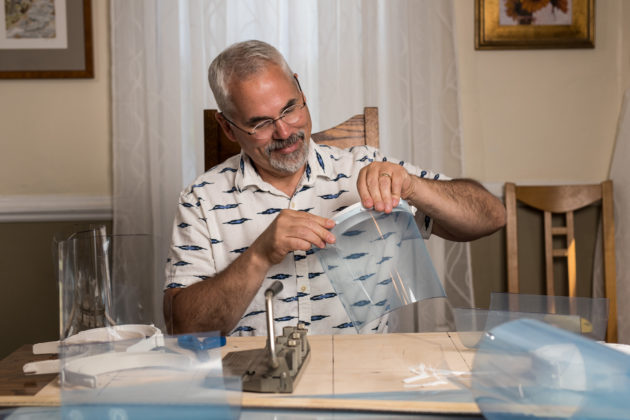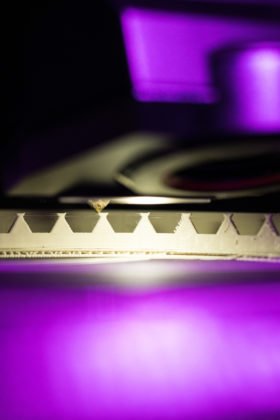Slippery Rock University faculty and staff collaborated over the course of the pandemic to 3-D print face shields for front-line workers.
Jack Livingston, geography, geology, and the environment professor, was one of several SRU faculty members who contributed to the university’s 3-D printing efforts. Livingston said that while the primary goal was obviously to create masks for those in need, the project also helped to bring the SRU community closer together.
“We were able to come together and do something, and it felt like this was a place where we could actually make an impact, even if it was just something small,” Livingston said. “Our mission was to do whatever we could do to help our staff, our students, and our community.”
Livingston said the project came to life when Michael Zieg, another professor in his department, found an article showing that people were printing N95 masks with filters and asked Livingston if the same could be done with the university’s equipment. Livingston found that it could be done, but there were some stumbling blocks in the process.
The primary issue with printing N95 masks, Livingston said, was that the copper-infused filament required to actually print them was in low-supply. Beyond that, Livingston cited the slow speed of the available 3-D printers as a reason for switching gears.
“There are some places like MIT that have industrial level printers, and we didn’t want to be taking filament that could be going to a better place,” Livingston said. “There were a lot of groups that were asking ‘well, what are the other types of things that we can do?’ and I found that printing face shields was an option.”
The option of printing face shields instead of masks was pitched to Zieg and it quickly gained traction throughout the entire university. Livingston said that just about every department that had access to a 3-D printer wanted to get involved.
“All of these people came together, figured out how to print the face shields, and then actually took the printers home with them,” Livingston said. “We were all printing these things out of our houses while the university was locked down.”
Livingston and his team began production of the first set of face shields at the end of March, continuing their efforts until the middle of June. Production began again briefly in July, but Livingston said that, once classes began again, the faculty agreed to shift their focus for the time being.
Going forward, Livingston said that there have been talks of continuing to expand SRU’s 3-D printing capabilities. Within the next year, Livingston said that the hope is to create a lab specifically for 3-D production.
“This is a technology that’s been on campus, but that most students have had very little interaction with,” Livingston said. “There’s a lot of potential there, it’s got a lot of potential to become a bigger part of what we do.”











